
(a)
Interpretation:
The Lewis formula of
Concept Introduction:
Lewis Structure: A Lewis structure shows a covalent bond as pair of electrons shared between two atoms.
Procedure to write Lewis formulas:
- 1) The symbols of the atoms that are bonded together in the molecule next to one another are arranged.
- 2) The total number of valence electrons in the molecule is calculated by adding the number of valence electrons for all the atoms in the molecules. If the species is an ion, then the charge of ion into account by adding electrons, if it is a negative ion or subtracting electrons if it is a positive ion.
- 3) A two-electron covalent bond is represented by placing a line between the atoms, which are assumed to be bonded to each other.
- 4) The remaining valence electrons as lone pairs about each atom are arranged so that the octet rule is satisfied for each other.
Formal charge (F.C): The charges that assigned to each atom in a molecule or ion by a set of arbitrary rules and don not actually represent the actual charges on the atoms are called as formal charges.
The formal charge is calculated using the formula,
The Lewis structure with zero formal charge or least separated formal charges is the preferred structure of the molecule.
(a)
Explanation of Solution
The total number of valence electrons in
Number of valence electrons in hydrogen=
Number of valence electrons in oxygen=
Number of valence electrons in chlorine=
The total number of valence electrons is twenty-six.
One chlorine atom forms one bond with hydrogen and oxygen forms three bonds with that mean eight electrons are used to form that bonds and remaining eighteen electrons are used to satisfy the octet rule of oxygen atoms.
The Lewis formula is,
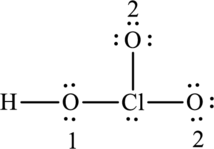
The formal charge for each atom is calculated as,
Formal charge on chlorine=
Formula charge on oxygen (1)=
Formula charge on oxygen (2)=
Formula charge on hydrogen=
The Lewis formula is,
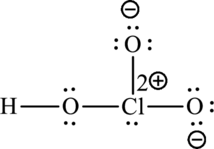
A large charge separation can be seen in the structure, this can be avoided by adding two pi bonds between oxygen and chlorine. The chlorine atom can expand the octet rule since it belongs to period three. The final Lewis structure is,

(b)
Interpretation:
The Lewis formula of
Concept Introduction:
Refer to part (a).
(b)
Explanation of Solution
The total number of valence electrons in
Number of valence electrons in hydrogen=
Number of valence electrons in oxygen=
Number of valence electrons in nitrogen=
The total number of valence electrons is eighteen.
One nitrogen atom forms one bond with hydrogen and two bonds with oxygen that means six electrons are used to form that bonds and the remaining twelve are used to satisfy the octet rule of atoms.
The Lewis formula is,

The formal charge for each atom is calculated as,
Formal charge on nitrogen=
Formula charge on oxygen (1)=
Formula charge on oxygen (2)=
Formula charge on hydrogen=
The Lewis formula is,

A large charge separation can be seen in the structure, this can be avoided by adding one pi bond between oxygen and nitrogen. The final Lewis structure is,

(c)
Interpretation:
The Lewis formula of
Concept Introduction:
Refer to part (a).
(c)
Explanation of Solution
The total number of valence electrons in
Number of valence electrons in hydrogen=
Number of valence electrons in oxygen=
Number of valence electrons in iodine=
The total number of valence electrons is thirty-two.
One iodine atom forms one bond with hydrogen and four bonds with oxygen that means ten electrons are used to form that bonds and the remaining twenty-two are used to satisfy the octet rule of atoms.
The Lewis formula is,
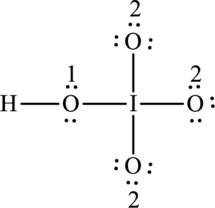
The formal charge for each atom is calculated as,
Formal charge on iodine=
Formula charge on oxygen (1)=
Formula charge on oxygen (2)=
Formula charge on hydrogen=
The Lewis formula is,
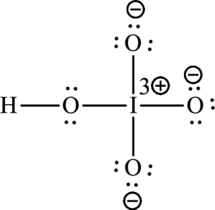
A large charge separation can be seen in the structure, this can be avoided by adding three pi bonds between oxygen and iodine. The iodine atom can expand the octet rule since it belongs to period five. The final Lewis structure is,
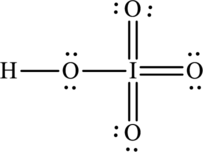
(d)
Interpretation:
The Lewis formula of
Concept Introduction:
Refer to part (a).
(d)
Explanation of Solution
The total number of valence electrons in
Number of valence electrons in hydrogen=
Number of valence electrons in oxygen=
Number of valence electrons in bromine=
The total number of valence electrons is twenty.
One bromine atom forms one bond with hydrogen and two bonds with oxygen that means six electrons are used to form that bonds and the remaining twelve are used to satisfy the octet rule of atoms.
The Lewis formula is,

The formal charge for each atom is calculated as,
Formal charge on bromine=
Formula charge on oxygen (1)=
Formula charge on oxygen (2)=
Formula charge on hydrogen=
The Lewis formula is,

A large charge separation can be seen in the structure, this can be avoided by adding one pi bonds between oxygen and bromine. The bromine atom can expand the octet rule since it belongs to period four. The final Lewis structure is,

Want to see more full solutions like this?
Chapter 7 Solutions
Student Solutions Manual to Accompany General Chemistry
- Calculate the solubility of CaF2 in g/L (Kp = 4.0 x 10-8). sparrow_forwardFor the following reaction with excess reagent, predict the product. Be sure your answer accounts for stereochemistry. If multiple stereocenters are formed, be sure to draw all products using appropriate wedges and dashes. 1. EtLi, Et₂O CH₁ ? 2. H₂O*arrow_forwardWrite the systematic name of each organic molecule: structure 요 OH ہو۔ HO OH name X S ☐ ☐arrow_forward
- Predict the major products of this organic reaction. If there aren't any products, because nothing will happen, check the box under the drawing area instead. D ㄖˋ ید H No reaction. + 5 H₂O.* Click and drag to start drawing a structure. OH H₂Oarrow_forwardDraw one product of an elimination reaction between the molecules below. Note: There may be several correct answers. You only need to draw one of them. You do not need to draw any of the side products of the reaction 'O 10 + x 也 HO + 义 Click and drag to start drawing a structure.arrow_forwardWhat are the angles a and b in the actual molecule of which this is a Lewis structure? H- :0: C=N: b Note for advanced students: give the ideal angles, and don't worry about small differences from the ideal that might be caused by the fact that different electron groups may have slightly different sizes. a = 0° b=0 Xarrow_forward
- A student proposes the transformation below in one step of an organic synthesis. There may be one or more products missing from the right-hand side, but there are no reagents missing from the left-hand side. There may also be catalysts, small inorganic reagents, and other important reaction conditions missing from the arrow. • Is the student's transformation possible? If not, check the box under the drawing area. • If the student's transformation is possible, then complete the reaction by adding any missing products to the right-hand side, and adding required catalysts, inorganic reagents, or other important reaction conditions above and below the arrow. • You do not need to balance the reaction, but be sure every important organic reactant or product is shown. + This transformation can't be done in one step. T iarrow_forwardDetermine the structures of the missing organic molecules in the following reaction: H+ O OH H+ + H₂O ☑ ☑ Note: Molecules that share the same letter have the exact same structure. In the drawing area below, draw the skeletal ("line") structure of the missing organic molecule X. Molecule X shows up in multiple steps, but you only have to draw its structure once. Click and drag to start drawing a structure. X § ©arrow_forwardTable 1.1 Stock Standard Solutions Preparation. The amounts shown should be dissolved in 100 mL. Millipore water. Calculate the corresponding anion concentrations based on the actual weights of the reagents. Anion Amount of reagent (g) Anion Concentration (mg/L) 0.1649 Reagent Chloride NaCl Fluoride NaF 0.2210 Bromide NaBr 0.1288 Nitrate NaNO3 0.1371 Nitrite NaNO2 0.1500 Phosphate KH2PO4 0.1433 Sulfate K2SO4 0.1814arrow_forward
- Draw the structure of the pound in the provided CO as a 300-1200 37(2), 11 ( 110, and 2.5 (20arrow_forwardPlease help me with # 4 and 5. Thanks in advance!arrow_forwardA small artisanal cheesemaker is testing the acidity of their milk before it coagulates. During fermentation, bacteria produce lactic acid (K₁ = 1.4 x 104), a weak acid that helps to curdle the milk and develop flavor. The cheesemaker has measured that the developing mixture contains lactic acid at an initial concentration of 0.025 M. Your task is to calculate the pH of this mixture and determine whether it meets the required acidity for proper cheese development. To achieve the best flavor, texture and reduce/control microbial growth, the pH range needs to be between pH 4.6 and 5.0. Assumptions: Lactic acid is a monoprotic acid H H :0:0: H-C-C H :0: O-H Figure 1: Lewis Structure for Lactic Acid For simplicity, you can use the generic formula HA to represent the acid You can assume lactic acid dissociation is in water as milk is mostly water. Temperature is 25°C 1. Write the K, expression for the dissociation of lactic acid in the space provided. Do not forget to include state symbols.…arrow_forward
 ChemistryChemistryISBN:9781305957404Author:Steven S. Zumdahl, Susan A. Zumdahl, Donald J. DeCostePublisher:Cengage Learning
ChemistryChemistryISBN:9781305957404Author:Steven S. Zumdahl, Susan A. Zumdahl, Donald J. DeCostePublisher:Cengage Learning ChemistryChemistryISBN:9781259911156Author:Raymond Chang Dr., Jason Overby ProfessorPublisher:McGraw-Hill Education
ChemistryChemistryISBN:9781259911156Author:Raymond Chang Dr., Jason Overby ProfessorPublisher:McGraw-Hill Education Principles of Instrumental AnalysisChemistryISBN:9781305577213Author:Douglas A. Skoog, F. James Holler, Stanley R. CrouchPublisher:Cengage Learning
Principles of Instrumental AnalysisChemistryISBN:9781305577213Author:Douglas A. Skoog, F. James Holler, Stanley R. CrouchPublisher:Cengage Learning Organic ChemistryChemistryISBN:9780078021558Author:Janice Gorzynski Smith Dr.Publisher:McGraw-Hill Education
Organic ChemistryChemistryISBN:9780078021558Author:Janice Gorzynski Smith Dr.Publisher:McGraw-Hill Education Chemistry: Principles and ReactionsChemistryISBN:9781305079373Author:William L. Masterton, Cecile N. HurleyPublisher:Cengage Learning
Chemistry: Principles and ReactionsChemistryISBN:9781305079373Author:William L. Masterton, Cecile N. HurleyPublisher:Cengage Learning Elementary Principles of Chemical Processes, Bind...ChemistryISBN:9781118431221Author:Richard M. Felder, Ronald W. Rousseau, Lisa G. BullardPublisher:WILEY
Elementary Principles of Chemical Processes, Bind...ChemistryISBN:9781118431221Author:Richard M. Felder, Ronald W. Rousseau, Lisa G. BullardPublisher:WILEY





